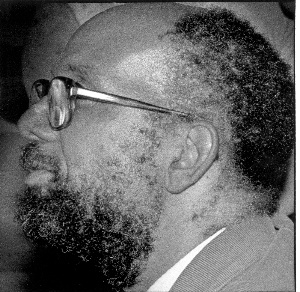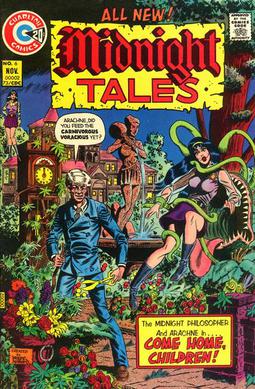Wayne Howard facts for kids
Quick facts for kids Wayne Howard |
|
|---|---|

Wayne Howard
|
|
| Born | Wayne Wright Howard March 29, 1949 Cleveland, Ohio, U.S. |
| Died | December 9, 2007 (aged 58) Derby, Connecticut, U.S. |
| Nationality | American |
| Area(s) | Penciller, Inker |
|
Notable works
|
Midnight Tales (Charlton Comics) |
| Spouse(s) | Carol (Zavednak) Howard |
Wayne Wright Howard (March 29, 1949 – December 9, 2007) was an African-American comic book artist. He was famous for his work in the 1970s at Charlton Comics. He was one of the first comic creators to have his name on the cover of his own series. His horror comic Midnight Tales proudly announced "Created by Wayne Howard" on every issue. This was very unusual for the time.
Contents
Biography
Early Life and Start in Comics
Wayne Howard was born in Cleveland, Ohio. He loved drawing from a young age. His first professional art job was in high school. He drew public service pamphlets for the city of Cleveland. These pamphlets taught people things like how to keep rats away.
He later went to Wesleyan University in Middletown, Connecticut. There, he earned a degree in arts. In the mid-1960s, he contributed to fan-made comic magazines called fanzines. Around 1969, he became an art assistant for the well-known comics artist Wally Wood in Long Island, New York.
Howard's first credited work in comics was in October 1969. He worked as a penciler and inker on a three-page story for DC Comics' House of Mystery #182. He also contributed to other issues of this comic.
Working at Charlton Comics
After his first story, Wayne Howard started working with Nicola Cuti. Cuti was a writer who later became an editor at Charlton Comics. Charlton Comics was a company in Derby, Connecticut. They were known for letting artists and writers have a lot of creative freedom.
Howard began working for Charlton in April 1972. He drew a story called "A Winner's Curse" for the comic Ghost Manor #4. For the next five years, he drew about 200 covers and stories. Most of his work was for supernatural comics like Ghostly Haunts and Ghostly Tales. His art style was often compared to his mentor, Wally Wood.
He also worked with writer Nicola Cuti on a backup story called "Travis: The Dragon Killer." This story appeared in the popular superhero comic E-Man #3 in June 1974.
Midnight Tales and Its Impact
Wayne Howard's most important contribution was setting a new standard for comic book credits. Years later, it became common for comics to say "created by" on the cover. This idea started with Midnight Tales.
Nicola Cuti, the writer and editor at Charlton, explained why Howard got this special credit. He said Midnight Tales was "his idea, his concept, his everything." Howard created the horror hosts of the comic, Professor Coffin and his niece, Arachne. These characters would even star in a story in each issue.
Howard also came up with the idea of having themed issues. For example, one issue might be all about "blob monsters." Howard drew almost every cover and story for Midnight Tales. He even wrote some of the stories himself.
Other Comic Work
Wayne Howard did not work for many other comic companies. He drew a story for Gold Key's The Twilight Zone comic in 1972. He also inked stories for Warren Publishing's black-and-white magazines Creepy and Eerie.
For DC Comics, he inked some horror stories in House of Mystery and Secrets of Haunted House. His last known original comic work was in 1982 for DC's Warlord #64.
He also worked for Marvel Comics, a very big company. He inked covers and stories for comics like Worlds Unknown and Marvel Team-Up. He worked on a Spider-Man and Sub-Mariner story in Marvel Team-Up #14.
Personal Life
Wayne Howard passed away at age 58 on December 9, 2007. He died at Griffin Hospital in Derby, Connecticut. At the time, he lived in Oxford, Connecticut, and was married to Carol (Zavednak) Howard.
George Wildman, who was an editor at Charlton Comics, said Howard was "sort of shy." His friend and frequent collaborator Nicola Cuti remembered that Howard always wore a similar outfit. He said Howard had many white shirts, tan jackets, black pants, and black ties.
See also


